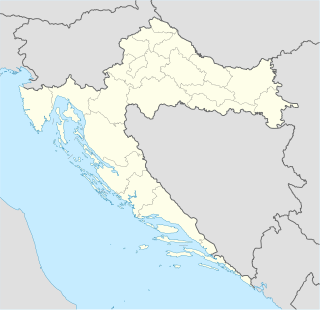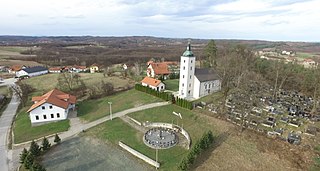Cerovica can refer to the following places:
- Bosnia and Herzegovina
- Serbia
- Slovenia
- Croatia
Cerovica can refer to the following places:

Samobor is a city in Zagreb County, Croatia. It is part of the Zagreb metropolitan area.

Labin is a town in Istria, Croatia, with a town population of 6,893 (2011) and 11,642 in the greater municipality.

Novi Grad, formerly Bosanski Novi, is a town and municipality in Republika Srpska, an entity of Bosnia and Herzegovina. Situated in the far northwest of the country, it lies across the Una from the Croatian town of Dvor. According to the 2013 census, the town has a population of 11,063 while its municipality comprises a total of 27,115 inhabitants.
Juraj Njavro was a Croatian medical doctor and politician.

Brovinje Italian: Brovigne is a small settlement/hamlet with a little more than 50 houses in 1950. As of the 2011 Croatian census, it had a population of 81. It is located in the Labinština peninsula of Istria County, Croatia. Overlooking the Gulf of Kvarner in the northern Adriatic Sea including the island of Croatian: Cres, Italian: Cherso. It is located 13 km south-east of Labin and 3 km north of Koromačno/Valmazzinghi. The first written record with the name Brovinje is recorded in the old St. Lucia church books on birth, marriages and deaths in 1705 which are held in Pazin, Istria. Brovinje is a hamlet which is under the Raša municipality.

Cerovica is a village in the municipality of Sokobanja, Serbia. According to the 2002 census, the village has a population of 54 people.

Cerovica is a village in the municipality of Kučevo, Serbia. According to the 2002 census, the village has a population of 381 people.

Cerovica is a village in the municipality of Stanari, Bosnia and Herzegovina.

Stanari is a village and municipality located in Republika Srpska, an entity of Bosnia and Herzegovina. It was established in 2014, after it split from Doboj municipality. As of 2013, it has a population of 6,958 inhabitants, while Stanari itself has a population of 1,015 inhabitants.

Cerovica is a settlement in the Municipality of Šmartno pri Litiji in central Slovenia. It lies east of Šmartno on the regional road to Mirna. The area is part of the historical region of Lower Carniola. The municipality is now included in the Central Slovenia Statistical Region.
Labinština is a peninsula which is 25 km long and 13 km wide. It is located on the eastern coast of Istria County in Croatia, and was named after the city of Albona/Labin which had control of the territory. Istria County was occupied by many invaders throughout its history. The County was made up of 16 Comuni; one of these was Albona/Labin. Albona was the head township of the Agro Albonese or Labinština under the Roman Empire in 177 BC, during the Venice Republic between 1365-1799, the Austria-Hungary Empire between 1814-1918 and many other occupations by foreign armies. During the Venetian and Austrian periods, Istria was divided into farming fractions or townships (comuni) each having a chief town called capo-comune.

Skitača is a small hamlet in northwest Croatia, in the eastern coast of Istria County, and is one of many settlements scattered in the County. These small settlements started to form in the 13-14th century continuing into the 19th century when Napoleon occupied the area. Even later when the Austria-Hungary got this region. During the early centuries most of the people came from the eastern parts of Europe as workers imported by rich landowners. Later, some came as refugees from territories taken by the Tatars and Turkish. Some of people which took refuge were Croats, Montenegrins, Serbs, Romanians, Bosnians, Albanians, Greeks, and other Eastern Europeans.

Cerovica as it was during the Venice Republic and the Austria-Hungary occupation. It was one of the 12 subdivisions as Commune or Parish in the District of Albona.

Sveti Lovreč Labinski is a small hamlet in Raša municipality, Istria County, Croatia. The church, built in the early 17th century, is also the Parish church and has the same name as the hamlet. During the Austria-Hungary occupation, it belonged to the municipality of Vlahovo, just west of the Municipality of Cerovica. The population of St. Lovreć Labinski in 2011 was 55.

The Istrian Circle or Circle of Istria was a province of the Kingdom of Illyria from 1825 until 1849. It was formed by merging the circle of Trieste with the district of Pisino, thus reuniting most of the Istrian peninsula. In 1849 Illyria was reincorporated into the Austrian Empire and Istria returned to being a crownland (Kronland) of Austria as the March of Istria. The capital of the Istrian Circle was Pisino. The circle was divided into the following districts: Albona, Bellai, Buie, Capodistria, Cherso, Dignano, Lussino, Montona, Parenzo, Buzet, Pirano, Pisino, Rovigno, Pula, Veglia and Volosca.

The Municipality of Šmartno pri Litiji is a municipality in the traditional region of Lower Carniola in southeastern Slovenia. The seat of the municipality is the town of Šmartno pri Litiji. The municipality is now included in the Central Slovenia Statistical Region.
Istria County is the most northern county in Croatia.
Cerovica is a settlement (naselje) in the Samobor administrative territory of Zagreb County, Croatia. As of 2011 it had a population of 5 people.

St. Lucia d'Albona is a small church in the hamlet of Skitaca, Istria County Croatia.

Cerovica is a village in the municipality of Neum, Bosnia and Herzegovina.